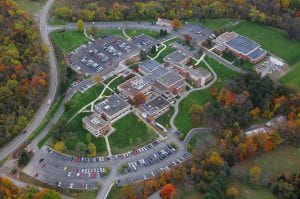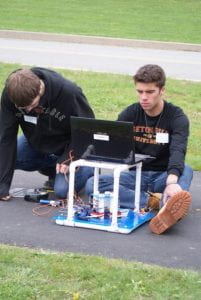- Location
- Date & Schedule
- Program Coordinator
- Facility Rules
- Weather
- Challenges
- Judges
- Participating Schools
Event Location
Penn State University – Abington Campus

Map
PDR Due Date
February 2019
Challenge Date
Tuesday, May 7th, 2019
Time – Challenge Day Event Schedule – Details TBD
Student Registration
Kickoff and Challenge Logistics
Morning Challenges
Lunch
Afternoon Challenges
Clean-up and survey (teams). Tally scores (judges)
Closing – remarks, recognition & awards
Challenge Program Contact
The Pennsylvania State University
Applied Research Laboratory
222 Northpointe Boulevard
Freeport, PA 16229
seaairland@eoc.psu.edu
Regional Challenge Host
Dr. Zafer Hatahet
Division Head, Science and Engineering
Penn State University Abington College
zuh11@psu.edu
Facility Rules
Conduct detrimental to the public interest or abuse of the building and grounds under any circumstances is expressly prohibited. The building, grounds, equipment and restrooms shall be left in a clean, orderly condition. Failure to do so may result in fees (as determined by the Owners) being assessed. No smoking is allowed in any building and no alcoholic beverages are permitted on the grounds.
Weather Considerations
The highest emphasis of safety will be placed on participants and staff. When there is lightning in the area, all outside activity will be suspended until the threatening weather leaves the area. Thank you for your understanding of our efforts to put safety first.
Challenges:
Sea – Underwater manned exploration is limited by the dangers of exposing humans to extreme pressure and temperature. Unmanned deep water exploration has thus become very common as humans seek to discover natural and man-made treasures found in the depths of the ocean. Unmanned submersibles have thus been used extensively in this role, and other deep water applications like oil extraction, communications infrastructure installation and object retrieval. In this challenge, you are going to develop a submersible to search for components of another unmanned submersible which has sunk. You are to search the wreckage for debris that will help the accident investigation team determine what went wrong. You must be able to discover and identify objects that are located on the sea floor and pick them up. You then have to place them into a vessel that will transport them to the surface while you continue on your search.
Sea Challenge Guidelines
| Sea Guidelines – 2018/2019 |
Air – There are a number of contained forest fires that require precise, aerial water drops due to their remote location. The exact location of these fires is not known, so a pilot must detect the correct location for the drop, and then carefully target the location with water drop. In the future, unmanned aircraft will perform this task to reduce costs and risks to pilots. Unlike a manned aircraft, which has an experienced pilot, the unmanned aircraft must carry its own sensors to detect the fire, and a method to remotely actuate the payload to drop the water. The first task in this challenge will be to perform payload drops into the fire areas. In addition to this task, in a normal firefighting operation, the ability to take pictures and provide situational awareness is also critical. Thus, the cameras that are used to detect the fire, may also be used to determine the location of firefighters, fire trucks or structures. This challenge provides the opportunity to build a payload that could one day perform these types of tasks on an unmanned aircraft.
| Air Guidelines – 2018/2019 |
Land – Ground robots are becoming increasingly more sophisticated and utilized in multiple types of applications including emergency situations. This application of the technology keeps first responders out of harm’s way, but still provides a critical link to injured or stranded people. In this challenge, we assume there are people trapped in a city building after an earthquake. The path to the building is deemed unsafe because of fear the structure will collapse. However, there are multiple individuals that require critical supplies to stay alive. Your robot and team must deliver supplies to the trapped people and remove hazardous materials and obstacles that are preventing rescue personnel from safely entering the structure.
| Land Guidelines 2018/2019 |
